A Nowcast/Forecast System for Japan’s Coasts Using Daily Assimilation of Remote Sensing and In Situ Data
Abstract
:1. Introduction
- (1)
- The horizontal resolution change from 1/12 to 1/36 degree;
- (2)
- The oceanic state DA update interval change from 4 days to 1 day; and,
- (3)
- The use of a more accurate representation of the tidal currents (a critical step to correctly estimate a realistic initial condition for a model that can output daily forecasts).
2. Methods and Data
2.1. A Regional Tide-Resolving Ocean Model JCOPE-T
2.2. Daily-Basis DA and Operational Forecast
2.3. Multiple Satellite SST Products with Bias Correction
2.4. In Situ Observation Data Used for Validation and Additional Assimilation
2.5. A Reference Case and Sensitivity Experiments
3. Results
3.1. Effects of the Direct DA Approach (Category 0 Experiments)
3.2. Effects of Assimilating the Merged Satellite SST (Category 1 Experiments)
3.3. Parameters Sensitivity of the DA Scheme (Category-2 Experiments)
3.4. Sensitivity of Assimilating In situ Temperature/Salinity/Ocean Current Data in Addition to Remote Sensing Data (Category 3 Experiments and an Additional Category 2 Experiment)
4. Discussion
5. Conclusions
Author Contributions
Funding
Institutional Review Board Statement
Informed Consent Statement
Data Availability Statement
Acknowledgments
Conflicts of Interest
Appendix A
| Sc (km) | SL (km) | Siau (km) | EOF in 39.5N–45N and 140E–150E | ||
|---|---|---|---|---|---|
| BASEX MGSST EXLMS | 50 | 100 | 9 | EOF-A | |
| SSTSL | 150 | 100 | 9 | EOF-A | |
| SSTER | 50 | 100 | 9 | EOF-A | |
| IAUSM | 50 | 100 | 27 | EOF-A | |
| 200KM | 50 | 200 | 9 | EOF-A | |
| SUMM3 INSTS LOCVL | 150 | 100 | 27 | EOF-A | |
| TSEOF INTS2 | 150 | 100 | 27 | EOF-B |
References
- Ezer, T.; Mellor, G.L. Continuous assimilation of Geosat altimeter data into a primitive equation Gulf Stream model. J. Phys. Oceanogr. 1994, 2, 832–847. [Google Scholar] [CrossRef]
- Ezer, T.; Mellor, G.L. Data assimilation experiments in the Gulf Stream region: How useful are satellite-derived surface data for nowcasting the subsurface field? J. Atmos. Ocean Tech. 1997, 14, 1379–1391. [Google Scholar] [CrossRef]
- Fujii, Y.; Kamachi, M. A reconstruction of observed profiles in the sea east of Japan using vertical coupled temperature-salinity EOF modes. J. Oceanogr. 2003, 59, 173–186. [Google Scholar] [CrossRef]
- Bell, M.J.; Schiller, A.; Le Traon, P.Y.; Smith, N.R.; Dombrowsky, E.; Wilmer-Becker, K. An introduction to GODAE Ocean View. J. Oper. Oceanogr. 2015, 8, s2–s11. [Google Scholar]
- Hirose, N.; Usui, N.; Sakamoto, K.; Tsujino, H.; Yamanaka, G.; Nakano, H.; Urakawa, S.; Toyoda, T.; Fujii, Y.; Kohno, N. Development of a new operational system for monitoring and forecasting coastal and open-ocean stats around Japan. Ocean Dyn. 2019, 69, 1333–1357. [Google Scholar] [CrossRef]
- Usui, N.; Fujii, Y.; Sakamoto, K.; Kamachi, M. Development of four-dimensional variational assimilation system for coastal data assimilation around Japan. Mon. Weather Rev. 2015, 143, 3874–3892. [Google Scholar] [CrossRef]
- Miyazawa, Y.; Murakami, H.; Miyama, T.; Varlamov, S.M.; Guo, X.; Waseda, T.; Sil, S. Data assimilation of the high-resolution sea surface temperature obtained from the Aqua-Terra satellites (MODIS-SST) using an ensemble Kalman filter. Remote Sens. 2013, 5, 3123–3139. [Google Scholar] [CrossRef] [Green Version]
- Sakamoto, K.; Tsujino, H.; Nakano, H.; Hirabara, M.; Yamanaka, G. A practical scheme to introduce explicit tidal forcing into an OGCM. Ocean Sci. 2013, 9, 1089–1108. [Google Scholar] [CrossRef] [Green Version]
- Varlamov, S.M.; Guo, X.; Miyama, T.; Ichikawa, K.; Waseda, T.; Miyazawa, Y. M2 baroclinic tide variability modulated by the ocean circulation south of Japan. J. Geophys. Res. Oceans 2015, 120, 3681–3710. [Google Scholar] [CrossRef]
- Miyazawa, Y.; Kagimoto, T.; Guo, X.; Sakuma, H. The Kuroshio large meander formation in 2004 analyzed by an eddy-resolving ocean forecast system. J. Geophys. Res. Oceans 2008, 113, C10015. [Google Scholar] [CrossRef] [Green Version]
- Miyazawa, Y.; Zhang, R.C.; Guo, X.; Tamura, H.; Ambe, D.; Lee, J.S.; Okuno, A.; Yoshinari, H.; Setou, T.; Komatsu, K. Water mass variability in the Western North Pacific detected in a 15-year eddy resolving ocean reanalysis. J. Oceanogr. 2009, 65, 737–756. [Google Scholar] [CrossRef]
- Miyazawa, Y.; Varlamov, S.M.; Miyama, T.; Guo, X.; Hihara, T.; Kiyomatsu, K.; Kachi, M.; Kurihara, Y.; Murakami, H. Assimilation of high-resolution sea surface temperature data into an operational nowcast/forecast system around Japan using a multi-scale three-dimensional variational scheme. Ocean Dyn. 2017, 67, 713–728. [Google Scholar] [CrossRef]
- Donlon, C.; Robinson, I.; Casey, K.S.; Vazquez-Cuervo, I.; Armstrong, E.; Arino, O.; Gentermann, C.; May, D.; LeBorgne, P.; Piolle, J.; et al. The Global Ocean Data Assimilation Experiment High-resolution Sea Surface Temperature Pilot Project. Bull. Amer. Met. Soc. 2007, 88, 1197–1214. [Google Scholar] [CrossRef]
- Mellor, G.L.; Hakkinen, S.; Ezer, T.; Patchen, R. A generalization of a sigma coordinate ocean model and an inter comparison of model vertical grids. In Ocean Forecasting: Conceptual Basis and Applications; Pinardi, N., Woods, J.D., Eds.; Springer: New York, NY, USA, 2002; pp. 55–72. [Google Scholar]
- Nakanishi, M.; Niino, H. Development of an improved turbulence closure model for the atmospheric boundary layer. J. Metorol. Soc. Jpn. 2009, 87, 895–912. [Google Scholar] [CrossRef] [Green Version]
- Furuichi, N.; Hibiya, T.; Niwa, Y. Assessment of turbulence closure models for resonant inertial response in the oceanic mixed layer using a large eddy simulation model. J. Oceanogr. 2012, 68, 285–294. [Google Scholar] [CrossRef]
- Li, Y.; Gao, Z.; Lenschow, D.H.; Chen, F. An improved approach for parameterizing surface layer turbulent transfer coefficients in numerical models. Bound. Layer Meteorol. 2010, 137, 153–165. [Google Scholar] [CrossRef] [Green Version]
- Lindau, R. Climate Atlas of the Atlantic Ocean; Springer: Berlin/Heidelberg, Germany, 2001. [Google Scholar]
- Malevskii, S.P.; Girduc, G.V.; Egorov, B. Radiation Balance of the Ocean Surface; Gidrometeoizdat: Sankt-Petersburg, Russia, 1992. [Google Scholar]
- Payne, R.E. Albedo of the sea surface. J. Atmos. Sci. 1972, 29, 959–970. [Google Scholar] [CrossRef]
- Paulson, C.A.; Simpson, J.J. Irradiance measurements in the upper ocean. J. Phys. Oceanogr. 1977, 7, 952–956. [Google Scholar] [CrossRef]
- Clark, N.E.; Eber, L.; Laurs, R.M.; Renner, A.; Saur, J.F.T. Heat Exchange between Ocean and Atmosphere in the Eastern North Pacific for 1961–71; NOAA Tech. Rep. NMFS SSRF-682; US Department of Commerce: Washington, DC, USA, 1974.
- Egbert, G.D.; Erofeeva, S.Y. Efficient inverse modeling of barotropic ocean tides. J. Atmos. Ocean. Technol. 2002, 19, 183–204. [Google Scholar] [CrossRef] [Green Version]
- Bloom, S.C.; Takacs, L.L.; da Silva, A.M.; Ledvina, D. Data assimilation using Increment Analysis Updates. Mon. Weather Rev. 1996, 124, 1256–1271. [Google Scholar] [CrossRef] [Green Version]
- Sun, C.; Thresher, A.; Keely, R.; Hall, N.; Hamilton, M.; Chinn, P.; Tran, A.; Goni, G.; Petit de la Villeon, L.; Carval, T.; et al. The data management system for the Global Temperature and Salinity Profile Programme. In Proceedings of the OceanObs.09: Sustained Ocean Observations and Information for Society, Venice, Italy, 21–25 September 2009. [Google Scholar]
- Shibata, A. AMSR/AMSR-E SST algorithm developments; removable of ocean wind effect. Ital. J. Remote Sens. 2004, 30/31, 131–142. [Google Scholar]
- Kurihara, Y.; Murakami, H.; Kachi, M. Sea surface temperature from the new Japanese geostationary meteorological Himawari-8 satellite. Geophys. Res. Lett. 2016, 43, 1234–1240. [Google Scholar] [CrossRef] [Green Version]
- Kurihara, Y.; Murakami, H.; Ogata, K.; Kachi, M. A quasi-physical sea surface temperature method for the split-window data from the Second-generation Global Imager (SGLI) onboard the Global Change Observation Mission-Climate (GCOM-C) satellite. Remote Sens. Environ. 2021, 257, 112347. [Google Scholar] [CrossRef]
- Xu, F.; Ignatov, A. In situ SST Quality Monitor (iQuam). J. Atmos. Ocean. Tech. 2014, 31, 164–180. [Google Scholar] [CrossRef]
- Kawabe, M. Sea level changes south of Japan associated with the non-large-meander path of the Kuroshio. J. Oceanogr. Soc. Jpn. 1989, 45, 181–189. [Google Scholar] [CrossRef]
- Hanawa, K.; Mitsudera, H. About the daily averaging method of oceanic data. Bull. Coast. Oceanogr. 1985, 23, 79–87. [Google Scholar]
- Miyazawa, Y.; Guo, X.; Varlamov, S.M.; Miyama, T.; Yoda, K.; Sato, K.; Kano, T.; Sato, K. Assimilation of the sea bird and ship drift data in the north-eastern sea of Japan into an operational ocean nowcast/forecast system. Sci. Rep. 2016, 5, 17672. [Google Scholar] [CrossRef] [PubMed] [Green Version]
- Kurihara, Y.; Sakurai, T.; Kuragano, T. Global daily sea surface temperature analysis using data from satellite microwave radiometer, satellite infrared radiometer and in-situ observations. Weather Bull. 2006, 73, s1–s18. [Google Scholar]
- Kanada, S.; Tsujino, S.; Aiki, H.; Yoshida, K.M.; Miyazawa, Y.; Tsuboki, K.; Takayabu, I. Impacts of SST patterns on rapid intensification of typhoon Megi (2010). J. Geophys. Res. Atmos. 2017, 122, 13245–13262. [Google Scholar] [CrossRef] [Green Version]
- Kuragano, T.; Shibata, A. Sea surface dynamic height of the Pacific Ocean derived from TOPEX/POSEIDON altimeter data: Calculation method and accuracy. J. Oceanogr. 1997, 53, 585–599. [Google Scholar]
- Xu, X.-Y.; Birol, F.; Cazenave, A. Evaluation of coastal sea level offshore Hong Kong from Jason-2 altimetry. Remote Sens. 2017, 10, 282. [Google Scholar] [CrossRef] [Green Version]
- Boyer, T.P.; Antonov, J.I.; Baranova, O.K.; Coleman, C.; Garcia, H.E.; Grodsky, A.; Johnson, D.R.; Locarnini, R.A.; Mishonov, A.V.; O’Brien, T.D.; et al. World Ocean Database 2013; NOAA Atlas NESDIS 72; NOAA: Washington, DC, USA, 2013.
- Nakada, S.; Hirose, N.; Senjyu, T.; Fukudome, K.; Tsuji, T.; Okei, N. Operational ocean prediction experiments for smart coastal fishing. Prog. Oceanogr. 2014, 121, 125–140. [Google Scholar] [CrossRef]
- Takikawa, T.; Kanetake, M.; Itou, T.; Hirose, N. Hydrographic observations by fisherman and coastal ocean model—Salinity variations around Iki Island during cooling season. J. Adv. Mar. Sci. Technol. Soc. 2019, 25, 15–20. [Google Scholar]
- Ashton, K. That ‘Internet of Things’ Thing. Available online: https://www.rfidjournal.com/that-internet-of-things-thing (accessed on 13 March 2021).


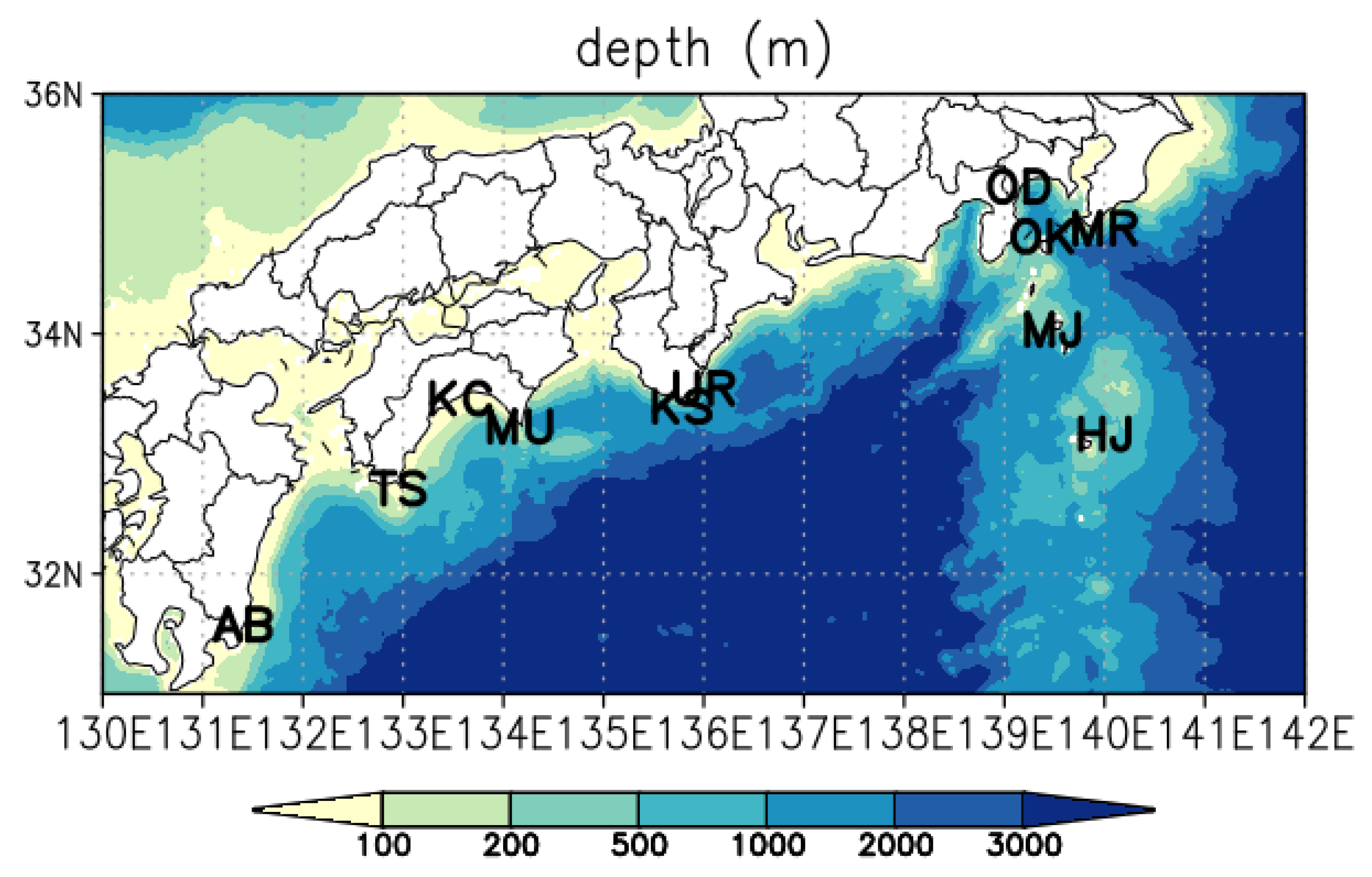
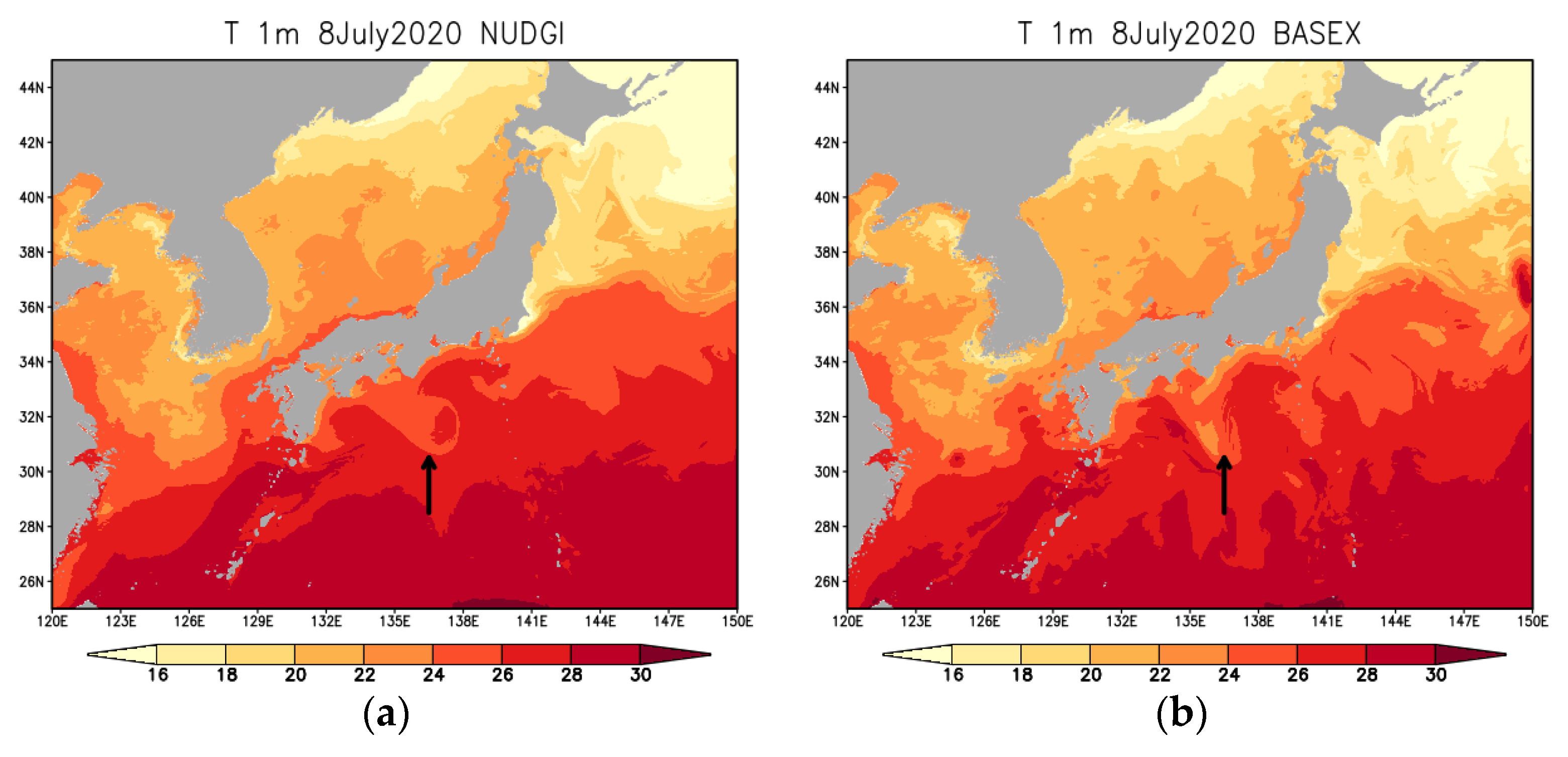
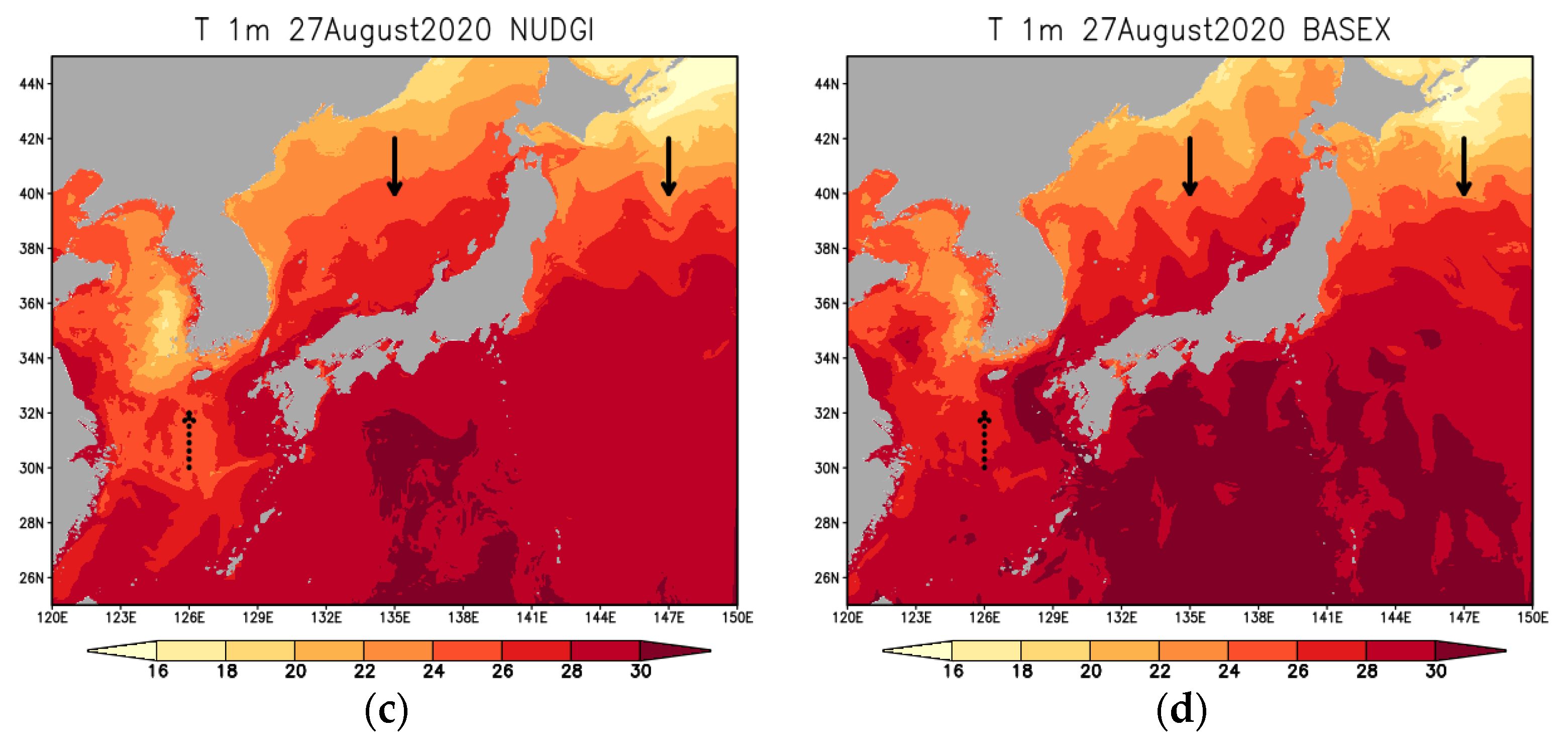
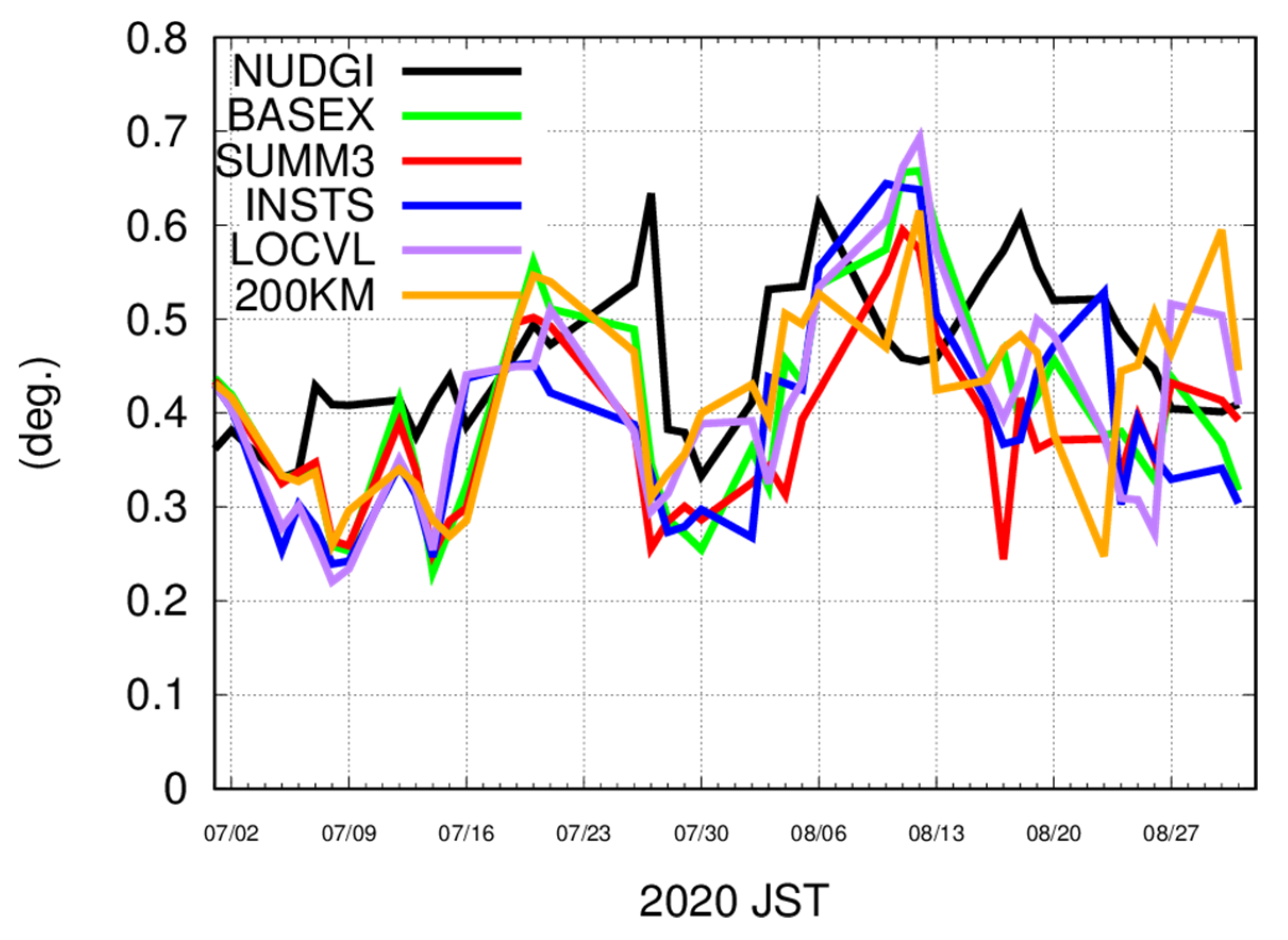
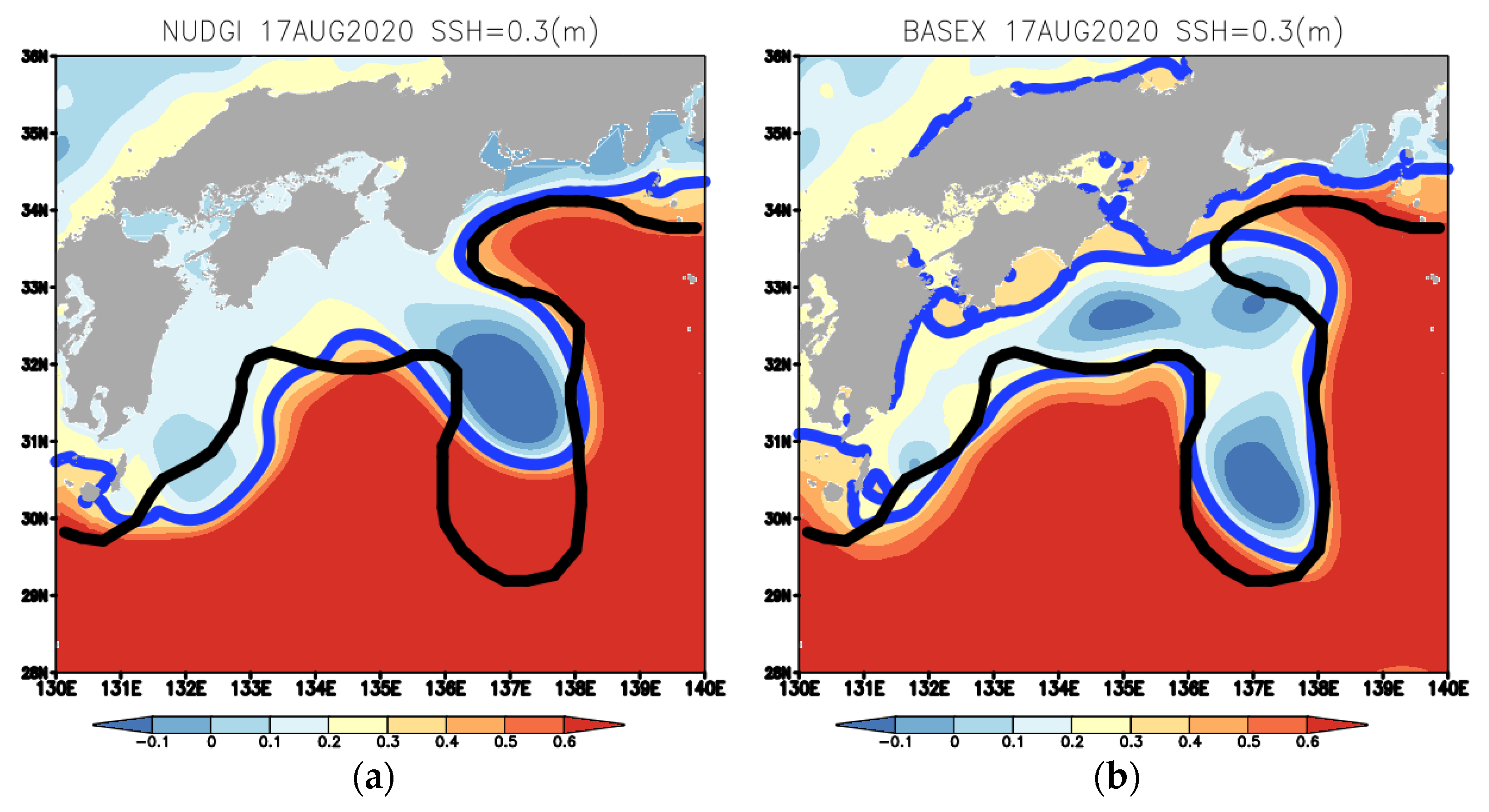


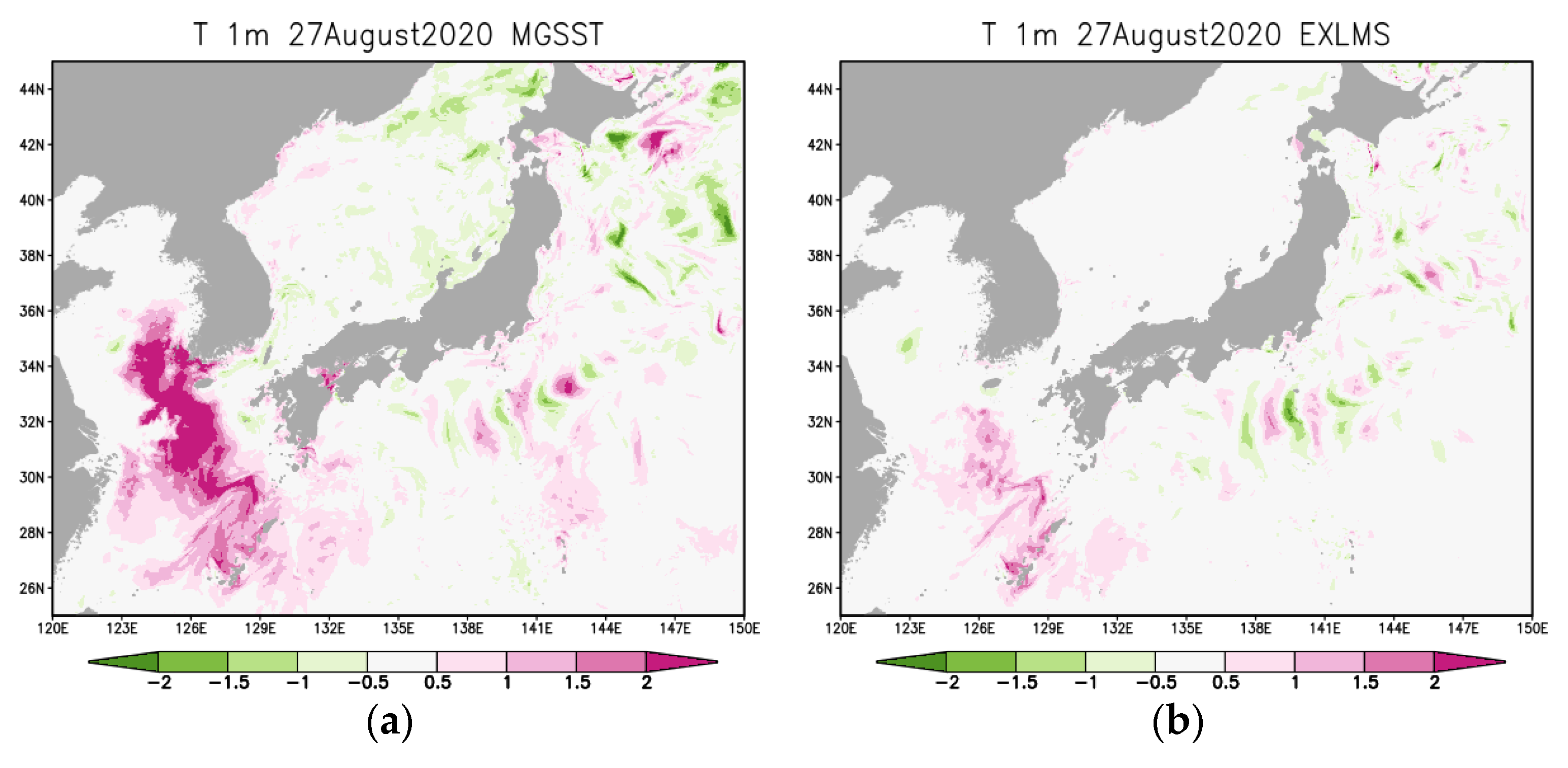

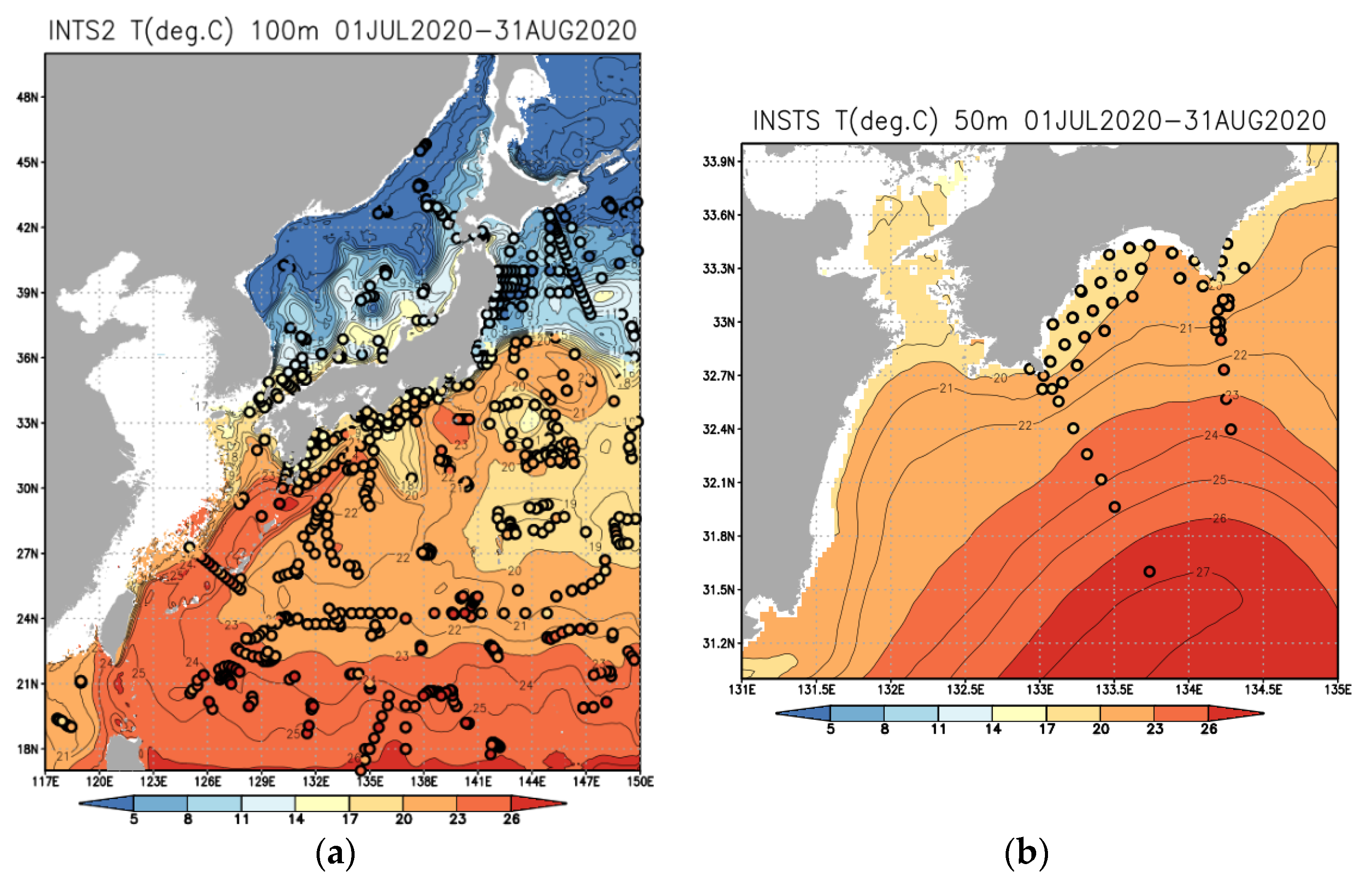
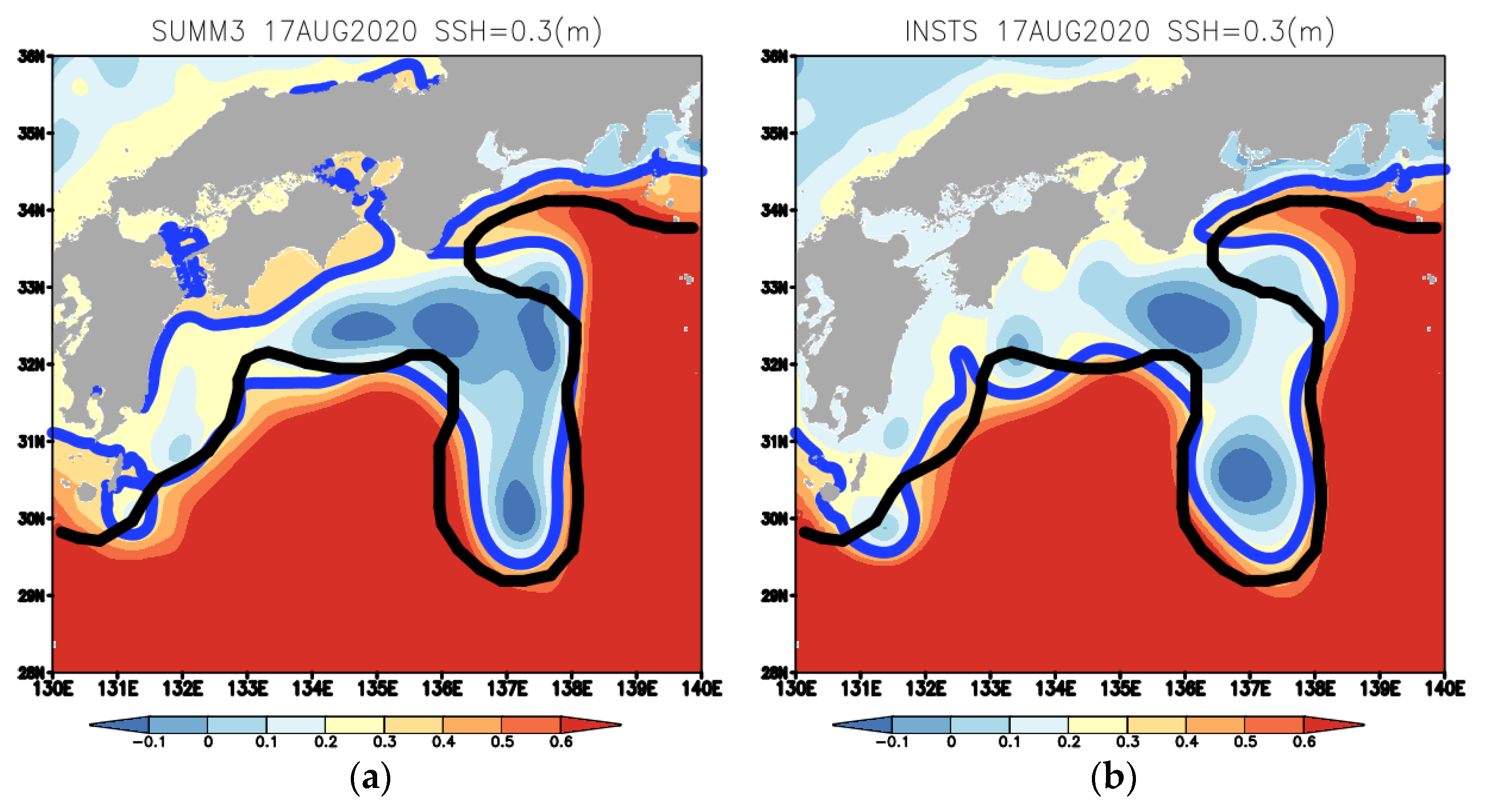


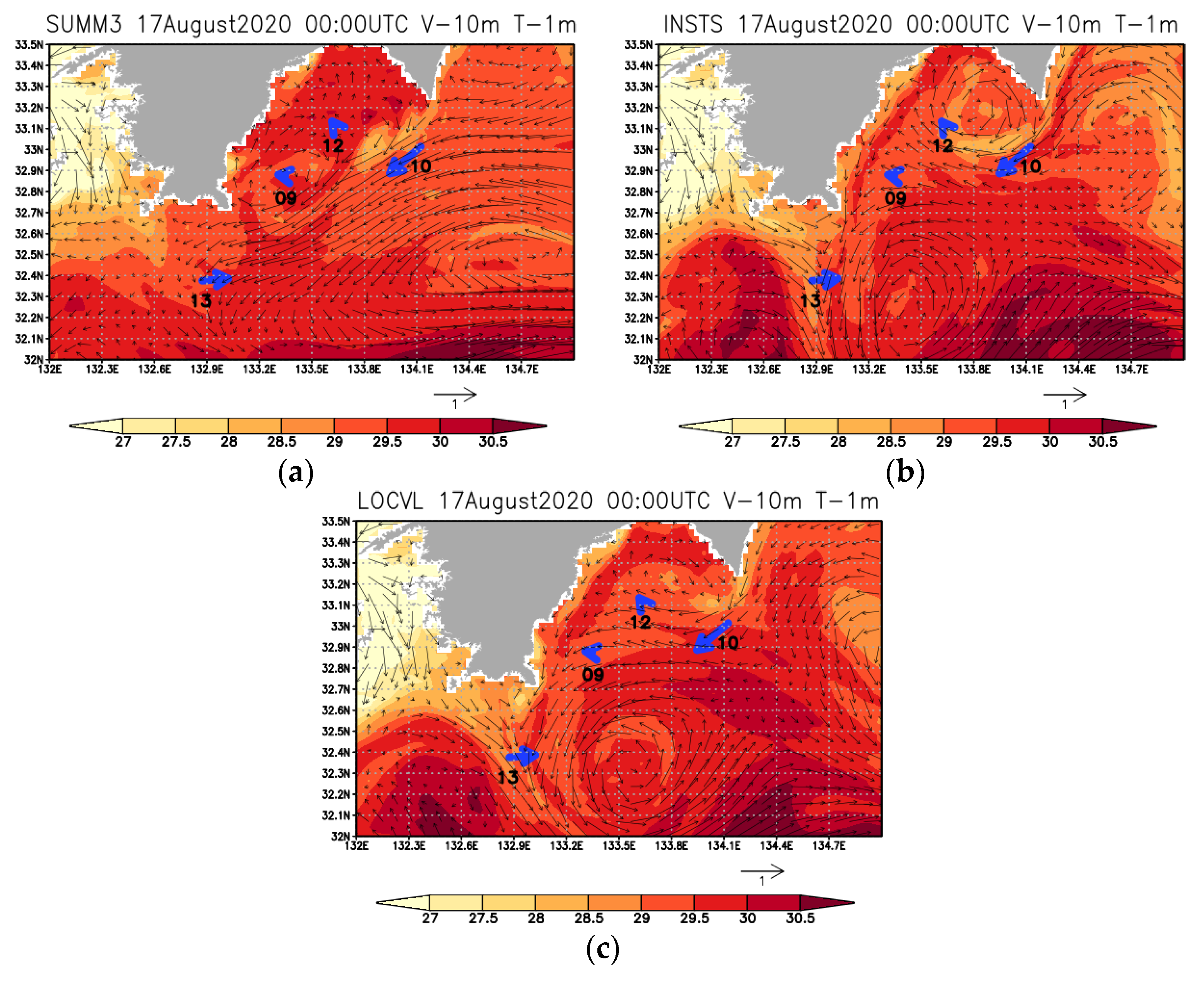
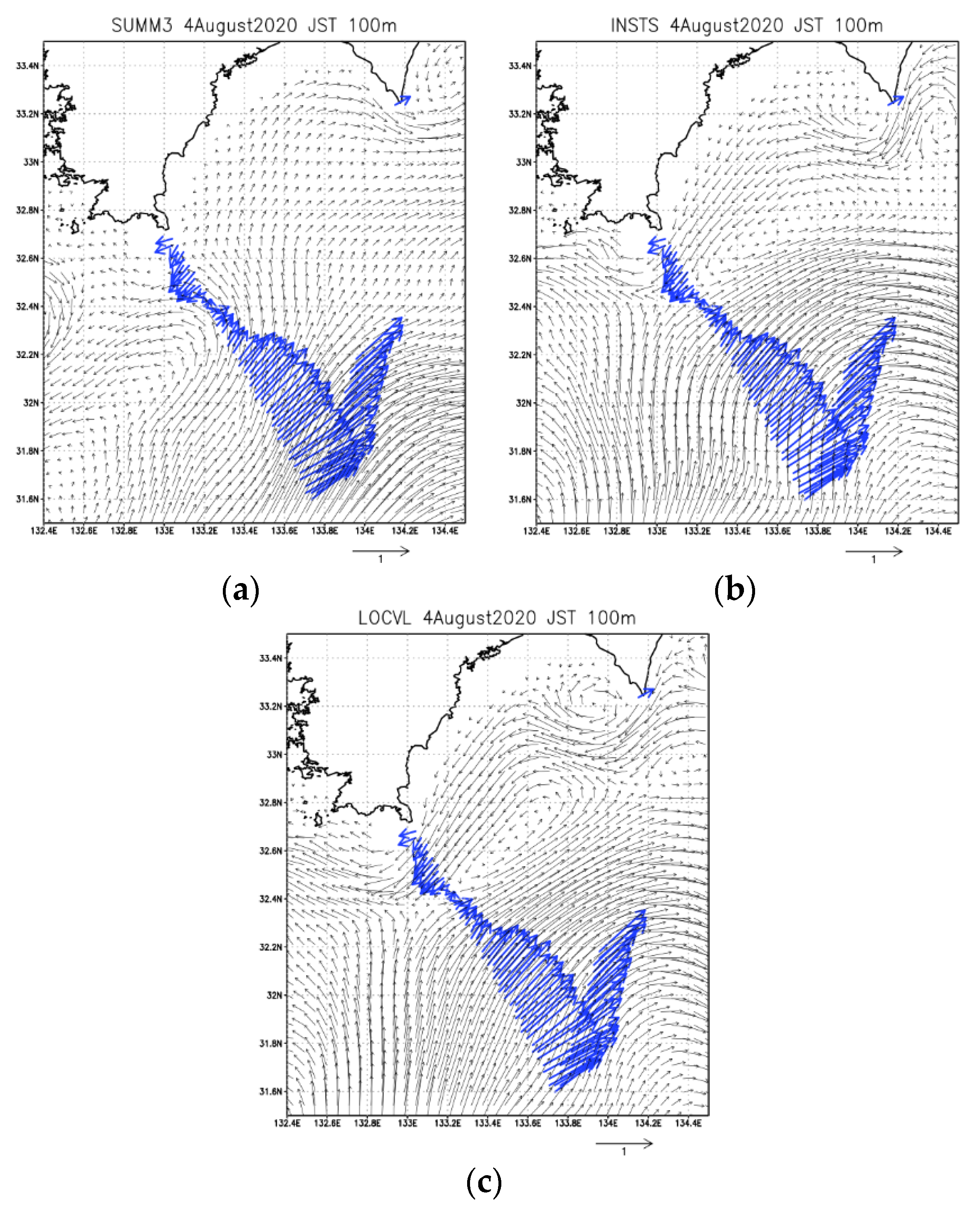
| Cases | Brief Description |
|---|---|
| Category 0 | |
| NUDGI | Nudging to JCOPE2M TS data |
| BASEX | A base case, assimilating the merged satellite SST () |
| Category 1 | |
| MGSST | Assimilating MGDSST instead of |
| EXLMS | Assimilating instead of |
| Category 2 | |
| SSTSL | Increase the separation scale from 50 km to 150 km |
| SSTER | Decrease the normalized SST error from 1.0 to 0.5 |
| IAUSM | Increase the IAU smoothing scale from 9 km to 27 km |
| 200KM | Increase the 3dVar covariance scale from 100 km to 200 km south of Japan |
| SUMM3 | SSTSL + SSTER + IAUSM |
| TSEOF | Using the different statics in MWR and decreasing SSH error from 0.1 m to 0.07 m in MWR and JSS + SUMM3 |
| Category 3 | |
| INSTS | Assimilating the in situ TS data into SUMM3 |
| INTS2 | Assimilating the in situ TS data into TSEOF |
| LOCVL | Assimilating the local ocean current data into INSTS |
| Cases | SOJ | JSS | EOJ | ECS |
|---|---|---|---|---|
| NUGDI | 0.65 | 0.61 | 0.90 | 0.79 |
| BASEX | 0.67 | 0.60 | 0.94 | 0.79 |
| MGSST | 0.53 | 0.54 | 0.91 | 0.61 |
| EXLMS | 0.67 | 0.61 | 0.94 | 0.77 |
| SSTSL | 0.72 | 0.65 | 0.95 | 0.81 |
| SSTER | 0.65 | 0.60 | 0.94 | 0.79 |
| IAUSM | 0.66 | 0.58 | 0.93 | 0.79 |
| 200KM | 0.61 | 0.60 | 0.94 | 0.79 |
| SUMM3 | 0.72 | 0.62 | 0.94 | 0.80 |
| SSHER | 0.71 | 0.62 | 0.94 | 0.80 |
| INSTS | 0.71 | 0.62 | 0.94 | 0.80 |
| INTS2 | 0.70 | 0.62 | 0.94 | 0.80 |
| LOCVL | 0.72 | 0.62 | 0.94 | 0.80 |
| Cases | SOJ | JSS | EOJ | ECS |
|---|---|---|---|---|
| NUGDI | 1.6 | 1.9 | 2.8 | 1.1 |
| BASEX | 1.4 | 1.8 | 2.5 | 1.0 |
| MGSST | 1.6 | 2.0 | 2.6 | 1.1 |
| EXLMS | 1.5 | 1.8 | 2.5 | 1.0 |
| SSTSL | 1.4 | 1.7 | 2.6 | 1.0 |
| SSTER | 1.4 | 1.8 | 2.4 | 1.0 |
| IAUSM | 1.4 | 1.7 | 2.6 | 1.0 |
| 200KM | 1.4 | 1.8 | 2.5 | 1.0 |
| SUMM3 | 1.4 | 1.6 | 2.7 | 1.0 |
| SSHER | 1.4 | 1.6 | 2.8 | 1.0 |
| INSTS | 0.9 | 0.9 | 1.9 | 0.7 |
| INTS2 | 0.9 | 0.9 | 1.9 | 0.7 |
| LOCVL | 0.9 | 0.9 | 1.9 | 0.7 |
| Cases | Ship | Buoys |
|---|---|---|
| NUGDI | 1.5 | 1.5 |
| BASEX | 1.5 | 0.9 |
| MGSST | 1.7 | 1.1 |
| EXLMS | 1.6 | 1.0 |
| SSTSL | 1.6 | 1.0 |
| SSTER | 1.5 | 0.9 |
| IAUSM | 1.5 | 1.0 |
| 200KM | 1.5 | 1.0 |
| SUMM3 | 1.6 | 1.0 |
| SSHER | 1.6 | 1.0 |
| INSTS | 0.8 | 1.0 |
| INTS2 | 0.8 | 1.0 |
| LOCVL | 0.8 | 0.9 |
| Cases | Ship | Ship(m/s) | Buoys | Buoys(m/s) |
|---|---|---|---|---|
| NUGDI | 0.40 | 0.20 | 0.02 | 0.27 |
| BASEX | 0.45 | 0.19 | 0.26 | 0.29 |
| MGSST | 0.44 | 0.19 | 0.32 | 0.28 |
| EXLMS | 0.42 | 0.20 | 0.31 | 0.29 |
| SSTSL | 0.43 | 0.20 | 0.30 | 0.28 |
| SSTER | 0.46 | 0.19 | 0.27 | 0.29 |
| IAUSM | 0.48 | 0.19 | 0.30 | 0.29 |
| 200KM | 0.39 | 0.20 | 0.24 | 0.29 |
| SUMM3 | 0.47 | 0.19 | 0.26 | 0.27 |
| SSHER | 0.49 | 0.19 | 0.26 | 0.28 |
| INSTS | 0.45 | 0.20 | 0.31 | 0.27 |
| INTS2 | 0.42 | 0.20 | 0.31 | 0.28 |
| LOCVL | 0.47 | 0.21 | 0.34 | 0.28 |
| Cases | KPATH | SLA |
|---|---|---|
| NUGDI | 0.46 | 0.60 |
| BASEX | 0.40 | 0.74 |
| MGSST | 0.39 | 0.73 |
| EXLMS | 0.39 | 0.77 |
| SSTSL | 0.40 | 0.71 |
| SSTER | 0.39 | 0.72 |
| IAUSM | 0.40 | 0.72 |
| 200KM | 0.42 | 0.72 |
| SUMM3 | 0.38 | 0.72 |
| SSHER | 0.38 | 0.72 |
| INSTS | 0.39 | 0.65 |
| INTS2 | 0.38 | 0.67 |
| LOCVL | 0.40 | 0.65 |
| Cases | BIAS |
|---|---|
| BASEX | 0.00 |
| MGSST | 0.62 |
| EXLMS | 0.16 |
Publisher’s Note: MDPI stays neutral with regard to jurisdictional claims in published maps and institutional affiliations. |
© 2021 by the authors. Licensee MDPI, Basel, Switzerland. This article is an open access article distributed under the terms and conditions of the Creative Commons Attribution (CC BY) license (https://creativecommons.org/licenses/by/4.0/).
Share and Cite
Miyazawa, Y.; Varlamov, S.M.; Miyama, T.; Kurihara, Y.; Murakami, H.; Kachi, M. A Nowcast/Forecast System for Japan’s Coasts Using Daily Assimilation of Remote Sensing and In Situ Data. Remote Sens. 2021, 13, 2431. https://0-doi-org.brum.beds.ac.uk/10.3390/rs13132431
Miyazawa Y, Varlamov SM, Miyama T, Kurihara Y, Murakami H, Kachi M. A Nowcast/Forecast System for Japan’s Coasts Using Daily Assimilation of Remote Sensing and In Situ Data. Remote Sensing. 2021; 13(13):2431. https://0-doi-org.brum.beds.ac.uk/10.3390/rs13132431
Chicago/Turabian StyleMiyazawa, Yasumasa, Sergey M. Varlamov, Toru Miyama, Yukio Kurihara, Hiroshi Murakami, and Misako Kachi. 2021. "A Nowcast/Forecast System for Japan’s Coasts Using Daily Assimilation of Remote Sensing and In Situ Data" Remote Sensing 13, no. 13: 2431. https://0-doi-org.brum.beds.ac.uk/10.3390/rs13132431







